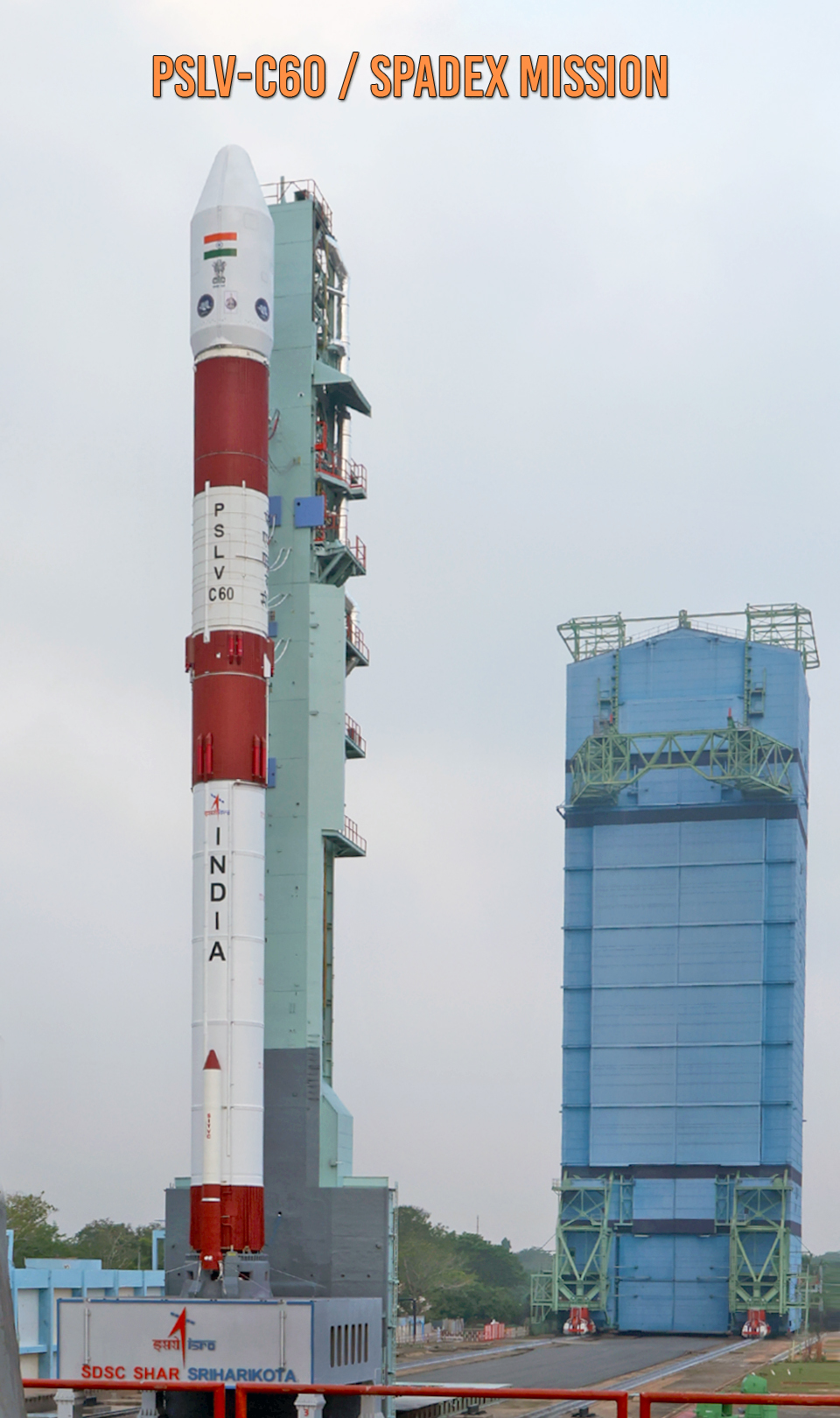
One of the SpaDeX satellites holding position at 15m
Sriharikota: In a significant achievement, the Space Docking Experiment (SpaDeX) mission accomplished its docking operation today, thereby positioning India among the select nations proficient in executing space docking manoeuvres.
This accomplishment represents a crucial milestone for upcoming missions such as the Bhartiya Antriksh Station, Chandrayaan 4, and Gaganyaan, with the support of the government enhancing the Indian Space Research Organisation (ISRO)’s initiatives. It also makes India only the fourth nation globally to reach this technological milestone.
The docking procedure was carried out with remarkable accuracy. The spacecraft transitioned effortlessly from the 15-meter to the 3-meter hold point, commencing the docking process with precision, which resulted in a successful capture of the spacecraft. Subsequently, the retraction was executed without any issues, followed by the rigidisation phase to ensure stability.

Mentionable is that the SpaDeX mission comprises two small satellites: SDX01, designated as the Chaser, and SDX02, identified as the Target, with each satellite weighing approximately 220 kilograms. These spacecraft are designed to be androgynous, meaning that either can function as an active spacecraft during the docking process. They are outfitted with solar panels, lithium-ion batteries, and a comprehensive power management system. The Attitude and Orbit Control System (AOCS) features various sensors, including star sensors, sun sensors, and magnetometers, along with actuators such as reaction wheels, magnetic torquers, and thrusters.
Post-docking, the two satellites have been effectively integrated and now operate as a single spacecraft and are controlled as a single entity, demonstrating India’s technological prowess. Electrical power is transferred from one satellite to the other which confirms the success of the docking.
In the upcoming days, operations for undocking and power transfer assessments are planned to further confirm the system’s functionality.
It may be recalled that ISRO initiated the mission on December 30, 2024, with the successful launch of the SpaDeX spacecraft utilizing the Polar Satellite Launch Vehicle (PSLV)-C60 from the Satish Dhawan Space Centre in Sriharikota. This pioneering mission is designed to demonstrate India’s technological capabilities in spacecraft rendezvous, docking, and undocking—essential skills for future developments in satellite servicing, space station operations, and interplanetary exploration.
SpaDeX represents a cost-efficient technology demonstration mission aimed at illustrating in-space docking capabilities through the use of two small spacecraft, which were launched aboard the 62nd PSLV flight. This mission is crucial for India’s aspirations in space, encompassing lunar exploration, sample retrieval, and the establishment of the Bharatiya Antariksh Station (BAS).
The primary objectives of the SpaDeX mission include:
1. Developing and demonstrating technology for rendezvous and docking with two small spacecraft.
2. Showcasing controllability while in a docked state.
3. Demonstrating the potential for prolonging the operational life of the target spacecraft.
4. Testing power transfer capabilities between the docked spacecraft.
This mission exemplifies India’s increasing self-sufficiency in advanced space technologies and reinforces ISRO’s dedication to enhancing its competencies to address future challenges in the dynamic arena of space exploration.
Prime Minister Narendra Modi extended his congratulations to ISRO and the entire space community for the successful demonstration of satellite docking. He noted that this achievement represents a crucial milestone for India’s ambitious space endeavours in the future. Minister of State for the Department of Space, Dr Jitendra Singh, pointed out that the historic moment came just days after the space agency, on January 12, 2025, brought the two spacecraft to three metres and then placed them back at a safe distance in its trial attempt to dock the satellites.
Cabinet approves the establishment of “Third Launch Pad”
Meanwhile, the Union Cabinet chaired by Prime Minister Modi today approved the establishment of the Third Launch Pad (TLP) at Satish Dhawan Space Centre of ISRO at Sriharikota, Andhra Pradesh, within 48 months at the cost of Rs. 3984.86 crore.
The expanded vision of the Indian Space Programme including the Bharatiya Antariksh Station (BAS) by 2035 and an Indian Crewed Lunar Landing by 2040 requires a new generation of heavier launch vehicles with new propulsion systems, which cannot be met by the existing launch pads.
Currently, India’s Space Transportation Systems depend entirely on two launch pads: the First Launch Pad (FLP) and the Second Launch Pad (SLP). The FLP was constructed three decades ago to support the Polar Satellite Launch Vehicle (PSLV) and continues to facilitate launches for both PSLV and the Small Satellite Launch Vehicle (SSLV). The SLP was primarily developed for the Geosynchronous Satellite Launch Vehicle (GSLV) and LVM3, while also serving as a backup for PSLV operations. Having been in operation for nearly 20 years, SLP has significantly increased launch capacity, enabling various commercial missions for PSLV and LVM3, in addition to national missions such as the Chandrayaan-3. Furthermore, SLP is preparing for the launch of the human-rated LVM3 for the Gaganyaan missions.
The Third Launch Pad project envisages the establishment of the launch infrastructure at Sriharikota for the Next Generation Launch Vehicles (NGLV) of ISRO and also to support as a standby launch pad for the Second Launch Pad at Sriharikota. This will also enhance the launch capacity for future Indian human spaceflight missions.
The TLP is designed to have a configuration that is as universal and adaptable as possible that can support not only NGLV but also the LVM3 vehicles with Semicryogenic stage as well as scaled-up configurations of NGLV. (Launch Vehicle Mark-3 or LVM3 is a three-stage medium-lift launch vehicle developed by ISRO. Primarily designed to launch communication satellites into geostationary orbit, it is also due to launch crewed missions under the Indian Human Spaceflight Programme).
– global bihari bureau





